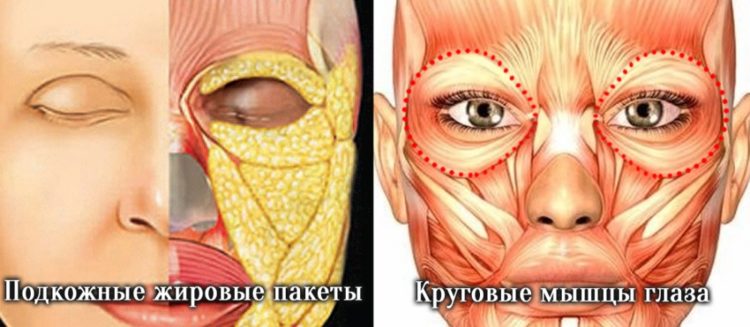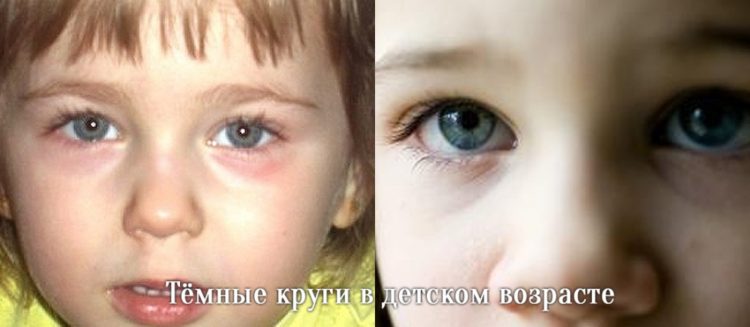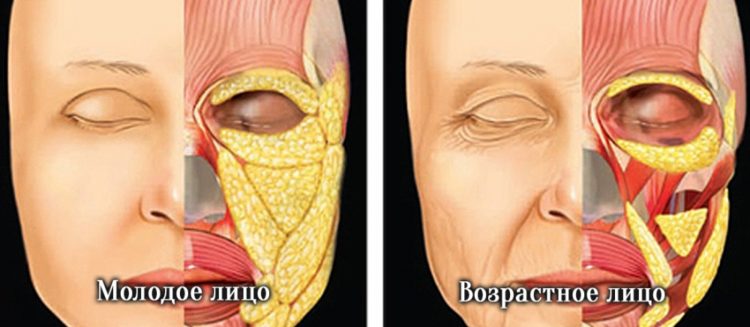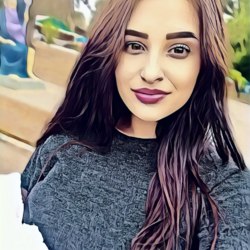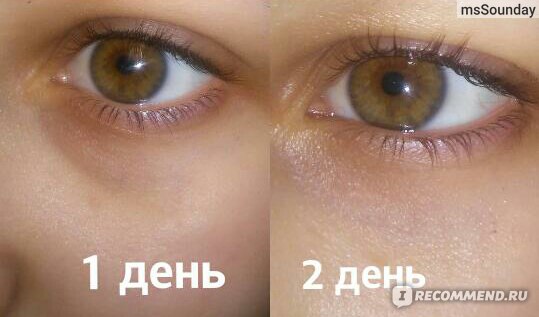Key points
Dark circles or bruises under the eyes are often a sign of tiredness and an unhealthy lifestyle, but hereditary problems can also occur.
Circles that form under the eyes cause a lot of problems and worry for women. They try to camouflage the blemish with concealers and foundations. But that doesn't solve the problem. You can only hide it, and it's only temporary.
In order to remedy the defect drastically, you must first identify the cause, carry out a diagnosis and only on the basis of the results should treatment methods be selected.
The main causes of dark circles under the eyes
Sleep deprivation
This is the most common cause of dark circles ("bruises") and puffiness ("bags") under the eyes. A good night's sleep or plenty of rest can help get rid of them.
Incorrect sleeping posture
Sleeping on a high, fluffy pillow, with your head elevated at a high angle, also leads to bags and puffiness under the eyes.
Fatigue
Often, the appearance of dark circles under the eyes is caused by excessive eye strain or overexertion, which are immediately reflected in the skin.
Improper nutrition
High levels of salt in the diet lead to a puffy face and bags under the eyes. This is due to its ability to retain fluid, which accumulates under the eyes in fatty tissue.
Alcohol and smoking
Such habits cause congestion in the blood vessels, resulting in bags under the eyes, irritation and redness of the eyes themselves.
The sun's rays
The sun's rays stimulate the production of melanin, the pigment that gives colour to human skin. Lack of sunglasses on the face in bright sunlight is what causes blue under the eyes.
Ageing of the body
Age-related changes in the skin manifest themselves as skin thinning, stretching and sagging due to weakened turgor. Fat begins to accumulate in the space created, eventually leading to the appearance of bags (hernias).
Pregnancy
During pregnancy, women experience swelling not only in their limbs but also in their face, which is caused by fluid retention in the body. This is what causes the bags to appear.
Heredity
A genetic predisposition for bags and circles under the eyes makes it possible for them to appear as early as childhood. This is due to the small thickness of the membrane between the subcutaneous tissue and the skin of the eyelids, which allows fatty tissue to penetrate under the skin over time and form the familiar unlovely puffiness.
Hormones
Changes in hormone levels are also a common cause of bags and circles under the eyes. This is due to the release of the hormone oestrogen, which contributes to the accumulation of excess fluid in the body.
Cosmetics
Often, personal intolerance is not taken into account when choosing cosmetics at short notice. However, cosmetic preparations obligatorily contain oils and fats, which can cause swelling of the eyelids if they get into the eyes. Also, these oils can clog the skin, thereby "weighing it down" and leading to bags.
Diseases
It's not always the case that puffiness and black eyes are a sign of an unhealthy lifestyle. Often, it is due to the presence of certain illnesses:
- Allergies. Accompanied by lacrimation, sneezing, reddening of the eyes, respiratory distress and coughing;
- Inflammations of the sinuses (sinusitis and maxillary sinusitis). They occur with painful sensations localised in the forehead and under the eyes, as well as profuse nasal discharge;
- Kidney disease. They cause fluid retention in the body, which not only causes swollen eyes, but also lower back pain and headaches;
- Thyroid disease. Thyroid disorders result in hormonal imbalance - general weakness, weight gain, changes in the menstrual cycle and swelling;
- Heart failure. It is accompanied by shortness of breath and rapid fatigue. Swelling and bruising under the eyes, almost invisible in the morning, appear in the evening;
- Skin diseases - eczema and dermatitis.
Detailed causes of dark circles under the eyes
The most common cause of dark circles under the eyes is overwork and chronic lack of sleep. Lack of sleep makes the skin pale and dull, making the blood vessels more visible and purple shadows under the eyes.
Improper care (or lack of care) of the eye area, improperly chosen cosmetics and the habit of rubbing your eyes with your hands also contribute to the appearance of dark circles under the eyes.
In many people, dark circles under the eyes are a genetic trait.
This can be due to the light and thin skin of the supraorbital area, the proximity of blood vessels and excessive pigmentation of the skin, which is hereditary and causes deep shadows under the eyes. Hereditary predisposition is often exacerbated by external factors: prolonged sitting in front of a computer monitor, bad habits (excessive consumption of alcohol, smoking, excessive sunbathing) and unhealthy diet (excessive consumption of caffeine, spicy food, canned food, etc.).
Another factor in the appearance of dark circles under the eyes is the natural process of ageing: as we age, the skin becomes thin and flabby, and the blood vessels become much more pronounced.
Dark circles under the eyes can be caused by dehydration, hypovitaminosis and severe dieting. Sometimes shadows around the eyes appear as a result of drastic weight loss over a very short period - in these cases, the causes of dark circles under the eyes may lie in both a loss of skin tone and a metabolic disorder.
Often dark circles under the eyes signal serious chronic conditions.
Such symptoms can occur with renal, adrenal and cardiac insufficiency, cholecystitis, cholelithiasis, gallstones, helminthiasis, giardiasis, anaemia, hypothyroidism and diseases of the nervous system. In children, dark circles under the eyes may occur with diseases of the nasopharynx (chronic tonsillitis), diseases of the teeth and gums, dystonia. Allergic reactions (allergic rhinitis, conjunctivitis, pollinosis), accompanied by dilated blood vessels and increased permeability of their walls, may also give the skin around the eyes a darker shade.
It is believed that the shade of dark circles under the eyes may accurately indicate disease of certain organs. For example, blue-purple circles under the eyes occur with circulatory disorders; reddish circles occur with allergies and kidney disease; yellow circles occur with liver and gallbladder problems; brownish circles may indicate chronic intoxication, worm infestation, etc.
People often confuse dark circles with bags under the eyes, mixing these fundamentally different problems into one.
- Bags under the eyes are formed due to the redistribution of so-called fat packs (hernias). Sometimes bags form due to ptosis of the skin in the area of the lower eyelid (read more about the formation of bags under the eyes).
- Dark circles (bruises) under the eyes, on the other hand, appear when there is a deficit of fat in the eyelid area. This can be caused by genetic, pathological or age-related factors. In the latter case, the problem can be a combination of both bruises and bags under the eyes.
It's important to realise that there is no single cause of under-eye circles - it's almost always a combination of reasons.
Let's take a look at the anatomical structure of the eye area:
To understand what causes the formation of circles, you need to understand the structure of this area. Let's think back to school anatomy lessons.
- Underneath the skin hides fat - the so-called 'fat packs of the face'. Underneath these are the circular muscles of the eye: they are responsible for squinching, squinting, blinking and other facial expressions.
Pay attention to the eye socket of the eye and remember how many blood vessels and capillaries there are in this area.
 It is important to realise that blood vessels and muscle tissues are rather 'dark' formations that are not very visible 'on the face' only thanks to the skin and subcutaneous fat that cover these structures. Thus, skin and fat are the main concealers of dark circles under the eyes.
It is important to realise that blood vessels and muscle tissues are rather 'dark' formations that are not very visible 'on the face' only thanks to the skin and subcutaneous fat that cover these structures. Thus, skin and fat are the main concealers of dark circles under the eyes.
Thinning of the fat layer
The most common cause of dark circles. The skin of the lower eyelids is separated from the circular muscle of the eye and the blood vessels by a thin layer of superficial fat.
- As we age, the surface fat thins, "goes away" and even through the thickest skin, the circular muscle of the eye and the blood vessels begin to show through. The muscle is a dark red colour and the blood vessels are blue-red.
- The colour of the circles depends on whether it is the blood vessels or the muscle that is more translucent. The colour of the dark circles has no connection with the kidneys, liver or other organs.
- Sometimes there is very little subcutaneous fat - this is a genetic trait. Dark circles and semicircles can then be seen since childhood.
Thin skin
The skin of the lower eyelids is the thinnest in the whole body. Beneath the skin there is a thin layer of fat, but if there is little fat and the skin is thin, the same blood vessels and muscles are visible to the light. If your blood vessels are close to the skin and your skin is light, you can see through even if you have fat!
Deep-set eyes
The lower eyelid is spatially located in the projection of the skull socket. Anatomically deep-set eyes visually create an "indentation" of the skin relief in the lower eyelid area and when lit, a shadow part is formed in this area, which visually creates a dark circle effect.
To better understand this point, let's take a look at the visualisation of another flaw - the nasolacrimal furrow - depending on the lighting.
Any age-related problem - whether it's a wrinkle, a pouch, a hernia or bad skin - is visible through just one thing: incident and reflected light.
The main point of anti-ageing aesthetic corrections is to work with the distribution of light and shadow on our face. Any furrow, crease or pouch is a play of light. Look at the illustrations - how the visual appearance of a nasolacrimal furrow varies depending on the direction of light.
We all realise that both natural daylight and artificial light fall mainly on our face from above. It is this direction of light that brings out all the irregularities on the face!
It's the same with deep-set eyes - the darkness of the lower eyelid is more dependent on the light.
Dark circles from pigmented skin
Acquired and congenital pigment is the cause of dark circles in normal anatomical structures. The Caucasian people have a genetic predisposition for pigmented skin in the lower and upper eyelids.
Pigmentation can appear with age and usually these dark circles do not have a clear border underneath.
Hereditary causes of dark circles under the eyes
Heredity is a key figure in the list of causes of dark circles under the eyes. But heredity itself is a very broad term.
Hereditary factors that provoke black eye formation, include:
- Specific facial anatomy (deep set or slightly bulging eyes);
- Thin skin;
- Close proximity of blood vessels to the skin in the eyelid area;
- Constitutional characteristics - an excessively lean physique with a general deficit of subcutaneous fat;
- Less common are chronic genetic diseases (e.g. heart or liver disease).
Dark circles under the eyes due to hereditary causes appear early - sometimes in childhood. Indirectly, bruising can be attributed to 'heredity' if it occurs at a young age, before the age of 20-25 (this is not the case in the norm).
If parents have dark circles at a young age, it is possible that the same fate will befall their child. And it doesn't necessarily have to have pathological "components".
Hereditary causes can also be attributed to skin characteristics: if the skin is thin, the vascular network of the periorbital area "shines through". This is usually the case for those with fair skin - dark circles can form by the age of 20, when the fat packs begin to thin.
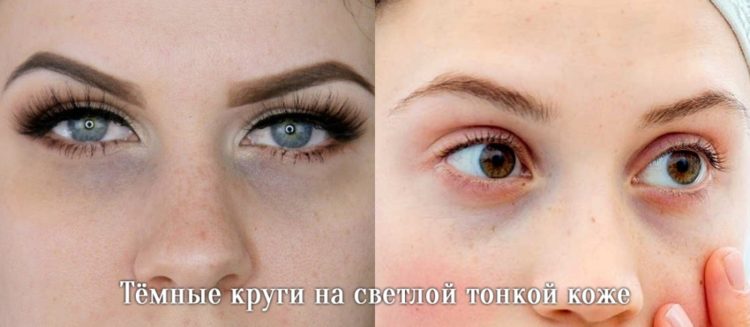 Sometimes hereditary factors combine - a person has thin skin in the periorbital area and circulation problems. The approach to such problems must also be comprehensive. There are fillers and other products available in modern cosmetology that work on different levels.
Sometimes hereditary factors combine - a person has thin skin in the periorbital area and circulation problems. The approach to such problems must also be comprehensive. There are fillers and other products available in modern cosmetology that work on different levels.
How to deal with hereditary causes?
As you understand, it is unlikely that heredity can be cured, so there is only one option for correction - correcting the lower eyelid area with fillers (contouring techniques). Even surgery won't make much difference.
The cost of such a correction - from 15000 roubles, the effect lasts up to 10-14 months.
Age-related changes and dark circles under the eyes
The most common cause of dark circles is age-related changes.
Age-related eyelid changes follow an approximate "timetable":
- 20-25 years old - the appearance of goosefoots;
- 25-30 years - the formation of a faint nasolacrimal furrow;
- 35-40 years old - the appearance of dark circles under the eyes;
- 40-45 years old - the formation of fat packs (hernias) of the lower eyelid;
- 45-50 years old - the growth of hernias (bags under the eyes);
- 45-55 years of age and beyond - ptosis of the upper and lower eyelids.
It is not possible to fit every person into this pattern - some age-related eyelid changes start earlier and others later. But there is an obvious fact: if professional care is ignored from the age of 30, regression will be more rapid and radical interventions will become relevant closer to the age of 40.
So, the main reason for the age-related appearance of dark circles is the thinning of the fat pack of the lower eyelid and the weakening of the ligament apparatus.
The circular eye muscle and ligaments stretch and sag with age. Moreover, the size of the eye socket increases with age and the zygomatic bone flattens.
The situation is aggravated by an age-related slowing down of metabolic processes and lymphatic drainage in this area.
To combat impaired lymphatic drainage and redistribution of subcutaneous fat with creams and ointments is frankly naive.
Even the most expensive cosmetics are not capable of 'sucking up' fat packets and redistributing tissue evenly to make up for deficiencies in the areas with dark circles under the eyes - this is obvious.
A good cream serves only as a supplement to full-fledged treatments in aesthetic medicine, but never replaces them.
Age-related dark circles under the eyes are also often caused by impaired blood supply, so that bags and puffiness soon follow. The congestion itself doesn't add to the beauty of the skin either - it becomes loose and has an earthy hue - pigmentation.
Bruising under the eyes due to illness, pigmentation
Any pathological processes in the body reflect badly on the appearance of the body. Interestingly, such aesthetic defects are the easiest to correct, but the problem is not solved on a global level. And a good cosmetologist (and a cosmetologist is a doctor) is obliged to warn the patient about this.
Increased pigmentation of the skin, caused by impaired melanocyte function, often occurs.
A simple example: due to liver disease, the patient develops so-called "liver spots". "Quenching" the activity of abnormally active melanocytes (cells that produce the pigment melanin) is an easy task for the beautician. It can be done by IPL method, with vitamin mesococktails, in addition smoothing the relief of the lower eyelid with fillers. But will it make your liver healthier? No! This means that the problem will soon return, which will cause mistrust towards the beautician and will kill his credibility in the eyes of the man. The same goes for heart, endocrine and other diseases.
Before you tackle the outward signs of illness, check and tidy up your health. This will ensure a successful and long-lasting facial transformation.
Some of the conditions that provoke dark circles under the eyes are on the list:
- Heart and kidney failure;
- Hypothyroidism;
- Adrenal dysfunction;
- Parasitic infestations;
- Gallstone disease;
- Cholecystitis;
- Anaemia;
- Vascular abnormalities (circulatory disorders);
- Hepatitis and other liver diseases;
- Chronic intoxication;
- Hypovitaminosis.
Bruises under the eyes caused by pathological processes in the body do not usually appear spontaneously and are "chronic".
Regimen correction, dietary adjustments and other tricks are powerless against them. If you notice such a problem along with specific symptoms, you should not only see a beautician, but also a general practitioner and if you discover the condition, you should undergo appropriate treatment.
Mode and dark circles under the eyes
In adults, bruises under the eyes are sometimes caused by the most trivial of reasons - irregularities.
Overwork, sleep deprivation and stress all contribute to thin, dull eyelid skin and a pale, haggard face. Metabolism is disrupted and the blood vessels of the eyelids become more prominent, creating a distinctive purple or bluish shadow under the eyes. A similar problem occurs with persistent dehydration caused by constant exposure to dry air and drinking little water (as well as smoking and alcohol abuse).
A healthy lifestyle is the best friend of beauty treatments. In tandem, it works without fail!
Try a two-pronged approach: get eight hours of sleep a night, eat right, get outdoors more often and also see a competent beautician. And you won't leave dark circles under your eyes a chance.
What does the colour of the circles say?
It is often claimed that the colour of the circles is indicative of some kind of malfunction in the body. We officially declare to all readers: there are no proven links between the colour of under-eye circles and diseases (organ work)!
The following can be stated more or less clearly:
- If the circles are dark blue or red/blue, the blood vessels and muscle are showing through the skin (we all remember the colour of raw meat).
- If the circles have a brown or yellow tinge, it is probably skin pigmentation.
- Combinations of shades are possible in the case of cumulative genesis of lower eyelid problems.
Diagnosing dark circles under the eyes
If you have dark circles under your eyes, don't try to cover them up with a thick layer of make-up. This will not solve the problem and will only exacerbate the cosmetic defect. The first step towards eliminating dark circles under the eyes is to find out why they occur.
- If lifestyle changes do not improve the condition of the skin around the eye area, you should see a general practitioner (gastroenterologist, endocrinologist, allergist - if you associate the dark circles with a specific medical condition).
- Laboratory tests may include blood counts, blood chemistry, urinalysis, spectral blood tests for trace elements, thyroid hormone tests, and stool tests for helminth eggs and giardia. Additional instrumental tests may include an electrocardiogram, abdominal, renal and retroperitoneal ultrasound.
- If an in-depth examination reveals no health problems, dark circles under the eyes are most likely a cosmetic flaw that needs to be addressed by a dermatocosmetologist.
Opinions/feedback from cosmetologists
The direct allergens in this case can be not only cosmetic products, but also plant pollen, house dust and pets.
Opinion from reputable international sources on the causes of dark circles under the eyes
We classified dark circles according to the causes of dark circles and tested the reliability of the parameter obtained in assessing the appropriateness of the tools used in this study by evaluating effectiveness. Also based on this study, we had to propose new methods that can be applied to evaluate the effectiveness of functional cosmetics for dark circles under the eyes.
Q&A
Treatments to get rid of dark circles under the eyes
If diagnosis shows no internal diseases, under-eye circles are a cosmetic defect resulting from an unhealthy lifestyle or hereditary predisposition.
In such cases, the most popular and effective treatments are
- Mesotherapy. Mesococktails containing arbutin, ascorbic acid, kojic acid and phytic acid are usually used. The therapy course includes 6-10 treatments, with a one-week break in between.
- Bioreparation with ascorbic acid (vitamin C). The combination of ascorbic acid and hyaluronic acid hydrates the skin around the eyes and visibly lightens the skin. The treatment course consists of 2-4 sessions, with a 2-week break in between.
- Plasmolifting. The treatment restores metabolism, normalises tissue respiration, activates blood microcirculation and thereby increases local immunity. This effect will manifest itself after 4-6 sessions at weekly intervals.
- Biorevitalisation. The skin around the eyes reacts strongly to dehydration and often looks unattractive due to dryness, creating a "tired eye" effect. A birevitalisation treatment consisting of 2-4 treatments at 2-week intervals can solve the problem.
- Contourplasty. If the blood vessels are close to the skin and "see through" the skin, the filler forms an additional layer so that the blood vessels are almost invisible. In addition, the preparations smooth out the nasolacrimal furrow.
- Laser peeling. The laser is used to remove the top layer of skin, which stimulates the regeneration process and promotes rejuvenation. The course of treatment involves 2-5 treatments with a month's break.
- Thin, dry skin around the eye area.
- Hyperpigmentation.
- Bags under the eyes (swelling of the subcutaneous tissue or fatty deposits).
- Mechanical damage to the skin.
- Close proximity of the vasculature.
- A deep tear sulcus.
Feedback from private users
And so, what is needed
2 tsp. chamomile
2 tsp. sage
1 tsp. parsley
And the recipe itself:
Take all the ingredients and pour 1 cup of boiling water over them. Let stand for 2 hours, strain and pour into an ice-cube. Wait until the cosmetic ice is ready and then proceed with the transformation.
Wipe your face twice a day, morning and evening, do not wash your face afterwards, it is better to do it before. At the beginning the circles will redden a little, so to speak, will be even more pronounced, but then within 5-10 minutes they will become lighter.
I did the course for 3 weeks but I was too short to do more and here is a photo of the result
Before and after photos of different treatments to get rid of dark circles
Causes of dark circles under the eyes
Men
Dark circles under the eyes occur with equal frequency in both men and women. They are difficult to treat at home and hardly disguise with make-up. But they can be corrected and treated.
Conclusion
The skin under the eyes is a special area. On average, it's about 0.5 millimetres thick. By comparison, it's 1.5 to 2 millimetres on the cheeks. The thin, almost translucent skin causes dark circles to form, making the face look tired and the eyes lose their expression. This only adds extra years to the face. But thanks to modern cosmetic procedures, it's easy to get rid of this problem.

